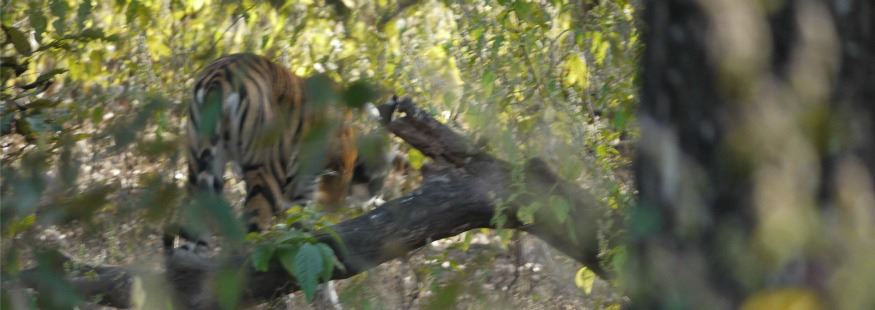Bennetts & 21st Century Tiger: Project Update

We have received an end-of-year update on the Mataki Tag Project from the 21st Century Tiger team on the ground in India.
The project team have spent the last several months working on a drop-off mechanism for large carnivores while continuing to trial the Mataki Tag on other species. Now in the final stages of testing, these drop-off devices will allow the team to make considerable progress with this exciting project. Next year they also plan to implement a camera trapping study in India provided the peer reviews of the proposal are favourable. We look forward to following both of these projects over the next twelve months!
Developing Mataki to aid the conservation of India’s tigers
February, 2014 saw the first ever deployment of IOZ’s open source, tracking devices on big cats. The team, working with partners in India (Wildlife Institute of India, Dehradun), were able to capture a large female Bengal tiger in Kanha National Park and fix our GPS and acceleration tracking tags – Matakai – to a pre-existing radio collar to collect high-resolution data on the movements and behaviour of this majestic animal. The tag was configured to collect data before a similar device, set up to communicate with the animal-borne tag, was used to wirelessly gather the data when within approximately 100m or less. This was achieved when the tiger was located again 3 days later resting under a tree, allowing the team to slowly approach her on elephant back and wirelessly retrieve the data.
Our Mataki tag successfully logged data continuously for three days. We were then able to successfully download 3 hours of this data remotely from elephant-back. While this is only a proportion of the data, this first field test has been invaluable in determining the best method for retrieving data in future. The recovered tracking data revealed some interesting patterns in daily activity patterns of the animal. It is hoped that with multiple success deployments of the tags on other individuals, in combination with the horizontal movements derived from the radio collar, will help us to determine behaviours such as hunting, feeding and resting of tigers within the national park and the habitats that are associated with these behaviours.
But it’s not just on tigers that we have been trialling this technique of wireless communication. Mataki tags have worked well with at the nesting sites of sea birds where the individuals spend long periods of time sufficient to allow all the data to pass between devices. Retrieving data on large carnivores from elephant back, although successful this time around, is clearly not always practical and so the team set about trying to design and develop a terrestrial ‘pop-off’ device.
The pop-off would be a mechanism to carry the tag for a predetermined time or until a remote switch is fired, that enables the tag to fall off the animal allowing us to collect it and directly obtain all of the logged data. Not as easy as it sounds when you factor in the additional weight, battery power needed, the fact that it will require moving parts and that the whole package needs to remain waterproof and relatively hard wearing to life around a 120 kg tiger’s neck.
However, many designs later, we are now in the final stages of testing our remotely operated pop-off device that retains the ethos of Mataki in that it will be low cost, light weight and open source, allowing conservationists to tailor the mechanism to their specific needs.
Testing within the Institute of Zoology has demonstrated the utility of the device that relies on a powerful, yet noiseless, pin breaking through a tie that is attached the tag to the tiger’s collar under tension, allowing it to fall away as the tension is released. The mechanism is fully enclosed and does not raise any welfare issues in addition to those relating to the collaring of the animal.
With these trials in their latter stages, the team is set to deploy the new, drop-off capable tags during the next field trip to India. We have plans to continue this work in Corbett National Park as part of a study focused on movements in and around protected areas being conducted by our colleague Dr Jhala of the Wildlife Institute of India.

Photo captions: Dr Jhala and team locating tigress for elephant
tracking, In the lab working on the pop-off, Pop-off device.
Banner image: Brief glimpse of collard tigress.


